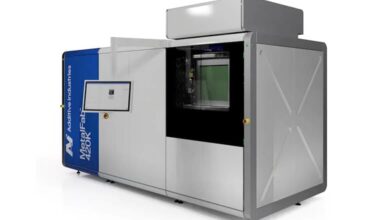4 Signs You Need to Upgrade Your Print Technology

“There are many reasons to invest in upgrading print technology for your business. Obsolete technology, including outdated hardware and software, can stall a business’s growth and progress. A simple example is that digitizing paper files can boost efficiency and productivity. Your team needs access to reliable, high-speed networks to achieve maximum uptime.
With Xerox Emirates being a leader in document management, we are at the core of software and hardware integration. We help businesses on their digital transformation journey. Delivering greater productivity and efficiency by automating workflows and digitizing data. This article will help business owners and managers who are thinking about upgrading & investing in new technology” – Simon Howells, General Manager, Xerox Emirates
When you’re running a busy print shop, it’s easy to lose sight of the bigger picture.
You’re so focused on getting work ‘out the door’, you don’t have time to ask yourself the big questions: How has the market changed? Am I keeping up or falling behind? How do I stack up against the competition? Does my business model still make sense? Where will I be in a year—or five years?
Often, the answers to these and other questions come down to the technology you’re using. After all, you’re only as productive, efficient, and competitive as your press(es). And if you haven’t upgraded in the last few years, you may be missing out on new business, or new opportunities with existing clients.
Here are four signs that it might be time to upgrade your print technology, to adapt to the industry shift from long to short runs and offset to digital.

- You’re Selling On Price
In recent years, there’s been a lot of downward price pressure in the print market due to the emergence of online print shops. With lower costs, larger client bases and faster delivery times, it can be hard for you to compete if you’re doing a lot of labor-intensive, low-value work.
Online print shops’ high-volume, low-margin model means they can usually undercut you on price for this type of work. And it’s not just the online competition. Your local competitors may also be selling on price to retain market share.
You may feel tempted to adopt the same strategy but competing on price is a race to the bottom – and that’s a race you never want to win. Instead, the answer is to differentiate yourself, offering value-added services that neither online nor offline competitors can match—delivering premium print jobs at premium prices. You could become a valued marketing partner instead of ‘just another print shop’. And upgrading your technology can help you get there.
- Held Back by Traditional Printing Methods
The pandemic has driven businesses to evolve their workflow. As businesses return to the new normal, there is an increased need for print-on-demand, cost – effective short runs, faster turnarounds, and high-quality jobs. Whilst there has undoubtably been an impact to the Print industry during the Pandemic, the legacy print methods have been impacted the most. Digital print technology excels at producing on demand and short print runs quickly and cost-effectively. Digital printing is also an ideal platform for personalization, allowing rapid image modification and messages using variable data printing (VDP). This has been growing in criticality within the print market, and has now accelerated significantly positioning digital printing for future growth.
Digital printing inks include cyan, magenta, yellow and black (CMYK) toner and ink, but also an extended color gamut of inks such as orange, blue and green as well as specialty dry inks for metallic (gold/silver), white or clear effects in addition to Fluorescent inks. This method of printing can print on everything from thick cardstock, heavyweight papers and folding cartons to fabric, plastics and synthetic substrates. T-shirt printing is a very popular digital printing application. With advancements in print quality and speed, digital printing machines are closing the gap on offset output. If you are ready to grow your business, it’s time to move from legacy print methods and embrace the current trends, as the future, is digital.
- You’re Turning Away Work You CouldDo
In the end, profitability and success come down to one thing: how fast you can get the work out. And your throughput is dictated by the limits of your technology.
Turning away work you know you could do — if only you had more hours in a day — is probably something you’re familiar with. But what choice do you have?
Print jobs take a long time to set up — especially complicated offset ones. Even repeat jobs sometimes take as long as the original, since all the parameters need to be re-entered. Heavier stock means running your press at lower speeds, which hits your productivity. The point is, you simply can’t get the work through fast enough to handle increased volumes and still meet client deadlines.
Or can you? With new print technology, quicker job setup and saved workflows make repeat print runs easier than ever. Speeds of 100 ppm on stocks up to 350 gsm and mixed media jobs means you’re getting the work out at a rapid pace.
- You’re Turning Away Work You Can’t Do
Adding value isn’t just at the top of your mind. It’s probably at the top of your customers’ wish list as well. Their expectations have been raised by an online world with endless choices, and they may increasingly be asking for things you can’t deliver.
Higher expectations mean more complexity. Perhaps they’re asking for new substrates like plastic/polyester, textile (such as linen or non-woven fabric), foil or promotional magnets. Or maybe they want complex jobs with elements (foldouts, graphics, tabbed dividers, different stocks, special folds, advanced finishes) that are beyond the capability of your current press to produce automatically.
So you’re faced with a difficult choice: turn these jobs away, or take them on and watch your labor costs skyrocket and productivity drop as you resort to manual processes.
Older presses simply can’t handle these lucrative, high-value print runs easily and efficiently. Which is frustrating, because you know there’s more money, and customer retention to be secured through this work.
The Time to Upgrade Is Now
As you can already see, there are plenty of great reasons to upgrade. If you haven’t already done so — either because you’re too busy or you think it’s going to cost too much — you may be missing out.
Technology has advanced faster than most print pros realize, and it costs a lot less than you think. Premium features now come standard on even entry-level presses. Plus, higher productivity and increased throughput mean the time to ROI is significantly shorter than with an older press.
So if you’re running a busy print shop and haven’t had the time to ask a few big questions lately, maybe now is the time. Time to come up for air and look at what new possibilities await with Xerox.





